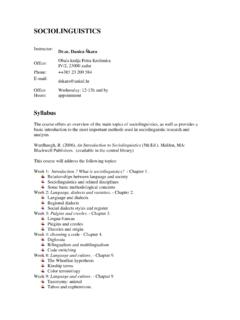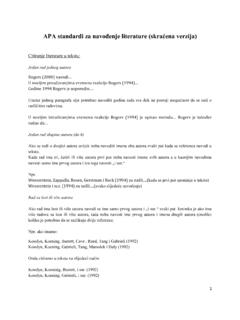Transcription of Introduction to English Morphology - unizd.hr
1 Introduction to English Morphology 14 October 2011 Morphology Several subfields of linguistic theory: phonology, phonetics, syntax, semantics, pragmatics, and Morphology . M. Phonology the selection of the form that manifests a given morpheme may be influenced by the sounds that realise neighbouring morphemes. ( Indefinite article a/an; we cannot describe the phonological shape of the indefinite article without referring to the sound at the beginning of the word that follows it.) M. - Syntax Interaction the form of a word may be affected by the syntactic construction in which the word is used.
2 The verb walk has a number of forms walk, walks, walked. The selection of a particular form of this verb on a given occasion is dependent on the syntactic construction in which it appears. M. Semantics the relationship between a word and its meaning is arbitrary. There is no reason why a word has the particular meaning that it has. Wimple? You have to memorise the fact that this word refers to a kind of mediaeval headdress. The Scope of Morphology Morphology : the branch of grammar that deals with the internal structure of words.
3 A sub-branch of linguistics not until the 19th century. Evolution, biology, Morphology metaphorical extensions (roots, family, ) Regarded as an essentially synchronic discipline, a discipline focusing on the study of word-structure at one stage in the life of a language rather than on the evolution of words. In American structural linguistics Morphology was studied as one linguistic level. The most important contribution of American structural linguists was recognition of the fact that words may have intricate internal structures.
4 Whereas traditionally linguistic analysis had treated the word as the basic unit of grammatical theory and lexicography, the American structuralists showed that words are analysable in terms of morphemes. These are the smallest units of meaning and/or grammatical function. The purpose of Morphology was the study of morphemes and their arrangements in forming words. Morpheme Some books are printed in bold typeface. Some, book+s, are, print+ed, in, bold, type+face 10 units From this structuralist analysis, we can conclude that morpheme is the minimal, indivisible, or primitive unit.
5 Meaning! The Scope of Morphology The name is a Greek-based parallel to the German Formenlehre the study of forms , and like many linguistic terms is 19th-century in origin (biology). The term itself is attributed to von Goethe who coined it in early 19th century in a biological context. (Aronoff, 2005) It is simply a term for that branch of linguistics which is concerned with the forms of words in different uses and constructions. In biology Morphology refers to the study of the form and structure of organisms; in geology it refers to the study of the configuration and evolution of land forms.
6 The Word We begin this study with one of the most fundamental units of linguistic structure: the word. How many words do we know? How do we use a finite vocabulary to deal with the potentially infinite number of situations we encounter in the world? Open-endedness of our vocabulary Words How many words? Children entering school 13000* A highschool graduate 60000* A literate adult 120000* + names of people, The list of words for any language is called lexicon. Existence of words in our native language is obvious, but in a foreign, incomprehensible language it is difficult to recognise words.
7 When you have mastered a language, you are able to recognise individual words without effort. * source: Akmajian, A. et al. 2001. Linguistics. Cambridge: MIT Press. p. 11 (quoted from Steven Pinker s Words and rules: The Ingredients of Language Word Properties What do we know when we know a word? What kind of information have we learned when we learn a word? information. For every word we know, we have learned a pronunciation. Part of knowing the word book is knowing certain sounds. structure information. For every word we have learned, we intuitively know something about its internal structure.)
8 Book-books (pl.) information. For every word we learn, we learn how it fits into the overall structure of sentences in which it can be used. Read-readable. Word properties information. For virtually every word we know, we have learned a meaning or several meanings. Knowing the word minister is to know that it has a certain meaning of a government official . We may or may not know other meanings. information. For every word we learn, we know not only its meaning or meanings but also how to use it in the context of discourse or conversation.
9 Hello is usually used to greet, but sometimes Hello! Can have other meanings, such as wake up .. We have seen that words are associated with a wide range of information and that each type of information forms an important area of study for a subfield of linguistics. What are words? We can say that a word friendship is a complex pattern of sounds associated with a certain meaning. Of course, this meaning is expressed with different sound patterns in different languages, The nature of the sound does not dictate what the meaning ought to be, so we say that the pairing of sound and meaning is said to be arbitrary.
10 As a first definition we might say that a word is an arbitrary pairing of sound and meaning. There are at least two reasons why this definition is inadequate. First, it does not distinguish between words and phrases or sentences, which are also (derivatively) arbitrary pairings of sound and meaning. Second, a word such as it in a sentence such as It is snowing has no meaning. The word is simply a placeholder for the subject position of the sentence. Therefore, not all sound sequences are words, and not all sound sequences that native speakers would identify as words have a meaning.


